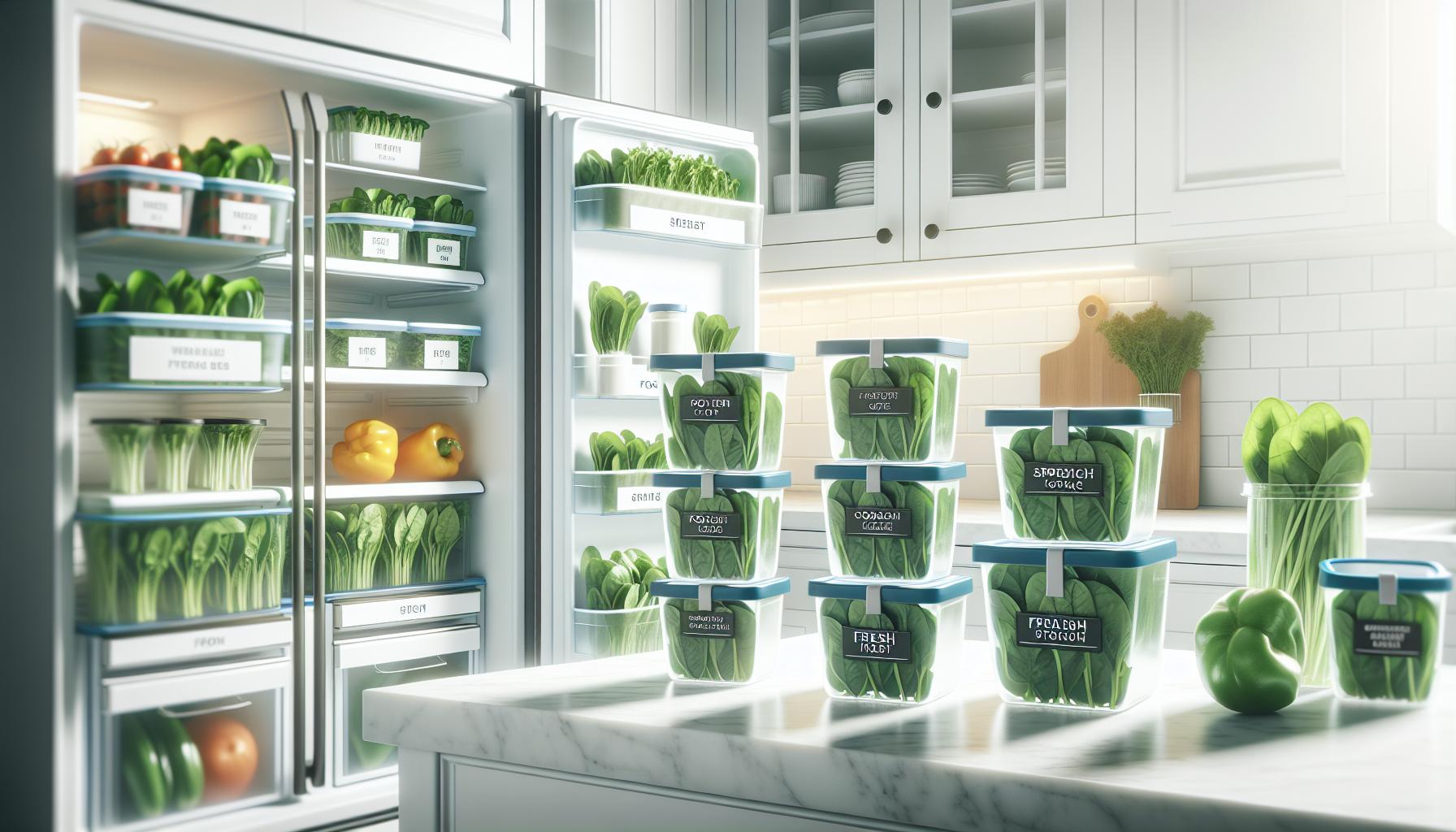Did you know that spinach is one of the most nutrient-dense vegetables, packed with vitamins A, C, and K, along with essential minerals? However, these leafy greens can quickly lose their freshness if not stored properly. Understanding how long spinach lasts in the fridge and the best storage tips is crucial for maximizing its shelf life and ensuring your meals are as healthy as possible.
When you bring home that vibrant bunch of spinach, you might be wondering how to keep it fresh and safe to eat. Spinach can be a staple in salads, smoothies, and cooked dishes, but no one wants to waste food or risk spoilage. By knowing the ideal storage conditions and recognizing the signs of freshness, you can enjoy this versatile green while minimizing waste. Keep reading to discover essential tips and timeframes for storing spinach effectively, so you can enjoy its many benefits longer and with confidence.
How Long Can You Keep Fresh Spinach?
Fresh spinach is a versatile and nutritious leafy green, but it has a relatively short shelf life, especially when stored improperly. Typically, you can keep fresh spinach in the refrigerator for about 3 to 7 days. This timeframe can vary depending on factors such as the freshness at purchase, the storage method, and the environment in which it’s kept. It’s essential to maximize its lifespan by understanding how to handle and store it effectively.
To ensure your spinach stays as fresh as possible, consider the following factors:
- Purchase Fresh: Always choose vibrant leaves that are crisp and free from wilt or yellowing.
- Storage Conditions: Store spinach in the refrigerator’s vegetable crisper, which maintains a slightly higher humidity level, ideal for greens.
- Packaging: Keep spinach in its original packaging or transfer it to a breathable container, such as a perforated plastic bag or a bowl covered with a damp paper towel.
While spinach may still be safe to eat beyond a week, its texture and flavor will deteriorate. Pay attention to the visual and tactile signs of freshness to determine its usability. Proper storage not only extends the spinach’s shelf life but also helps retain its nutritional value, so following these guidelines is key to enjoying fresh spinach in your meals.
Understanding Spinach Shelf Life and Spoilage

Fresh spinach is packed with nutrients, but its shelf life is relatively short, making it crucial to understand how to store it properly to prevent spoilage. When kept in the refrigerator, fresh spinach generally lasts between 3 to 7 days, but this can vary significantly based on several factors. The key determinants include the initial freshness at the time of purchase, storage conditions, and the overall handling of the leaves.
To maximize the longevity of fresh spinach, it’s important to remember that spinach thrives in a high-humidity environment. Therefore, storing it in the refrigerator’s vegetable crisper is ideal. This compartment is specially designed to maintain the moisture levels necessary for leafy greens. Additionally, the way you package the spinach plays a significant role in its shelf life. Keeping it in its original packaging or using a breathable container-like a perforated plastic bag or a bowl lined with a damp paper towel-will help maintain freshness longer by allowing air circulation while retaining moisture.
As time passes, the quality of spinach can deteriorate, even if it remains safe to consume. Wilting, yellowing, and a slimy texture are all indicators that spinach has gone bad. Consumption of spoiled spinach should be avoided as it may pose health risks. To enhance the freshness of your spinach, always choose leaves that are crisp, vibrant green, and avoid those that show signs of decay at the point of purchase. Following these guidelines diligently can help you enjoy fresh spinach for more mealtime possibilities while minimizing waste.
Proper Storage Methods for Fresh Spinach

Properly storing fresh spinach is essential to maintaining its vibrant color, crisp texture, and nutritional value. Spinach, known for its delicate leaves, can wilt quickly if not cared for correctly. To ensure you get the most out of your greens, it’s vital to follow specific storage methods that prevent spoilage and extend shelf life.
To start with, always aim to keep your spinach in a environment that mimics its natural growing conditions-cool and humid. The best place to store spinach is in the refrigerator’s vegetable crisper drawer. This compartment is specifically designed to retain moisture while protecting your greens from the harsh cold air that can lead to wilting. If you bought spinach packaged in plastic, you might consider keeping it in that package, as it often allows for some airflow. Alternatively, you can transfer it to a breathable container, such as a perforated plastic bag or a bowl lined with a damp paper towel, to help maintain humidity levels without trapping excess moisture, which can encourage mold growth.
When packing spinach for storage, gently rinse and dry it, but avoid soaking it, as excess water can lead to faster spoilage. If you find yourself with a larger batch, consider portioning it prior to storage to avoid unnecessary handling, which can damage the leaves. Place the spinach in a single layer when possible to prevent crushing and bruising, both of which can hasten decay.
If you need to store spinach for longer than a week, consider freezing it. Blanching the leaves in boiling water for just a minute or two and then plunging them into ice water before packing and freezing can help retain both flavor and nutrients. This method can preserve spinach for several months, making it a versatile option for soups, stews, and smoothies in the future.
By following these storage guidelines, you can maximize the freshness and lifespan of your spinach, turning this leafy green into a staple ingredient that adds both nutrition and color to your meals while minimizing waste.
Signs of Spoilage: When to Discard Spinach

Fresh spinach is a nutritious addition to your diet, but it can easily spoil if not stored properly. The key to enjoying spinach at its best lies in recognizing the signs of spoilage and when it’s time to discard it. Understanding these signs not only helps in maintaining food safety but also ensures that you reap the maximum benefits from this leafy green.
One of the most noticeable signs that spinach has gone bad is its visual appearance. Fresh spinach should be vibrant green, with crisp and intact leaves. When spinach starts to spoil, it may develop yellow or brown spots, indicating decay. If you notice drooping leaves or excessive wilting, this is a sign that the spinach is past its prime and not likely to be enjoyable in your meals. Additionally, any slimy texture on the leaves or a strong, unpleasant odor are clear indicators that the spinach should be thrown away.
It’s also essential to check the spinach for mold or other signs of fungal growth. If you see any white mold on the leaves, it’s best to discard the entire batch, as mold can spread rapidly, and some molds can produce toxins harmful to health. Always trust your senses-if it looks, smells, or feels off in any way, it’s best to err on the side of caution and dispose of it.
To extend the life of your spinach and reduce waste, aim to use it within 3 to 7 days of purchase, depending on its freshness at the time of purchase. When in doubt, it’s better to throw it out. Keeping an eye on these spoilage signs will help maintain not only the nutritional quality of your food but also your overall health by avoiding potentially spoiled produce.
Best Practices for Freezing Spinach
To keep spinach fresh and avoid waste, freezing is an excellent option that preserves its nutritional value and flavor. Unlike other vegetables that can lose their appeal once frozen, spinach freezes remarkably well, allowing you to enjoy its health benefits long after purchase. Freezing not only extends the lifespan of spinach but also provides convenient access for future meals.
Before you freeze spinach, it’s essential to prepare it properly. Start by washing the leaves thoroughly to remove any dirt or grit. After rinsing, blanch the spinach by briefly boiling it for about 2 minutes, then plunging it into ice water. This step is crucial as it helps maintain the vibrant green color, reduces the bitter flavor, and neutralizes enzymes that can lead to spoilage even in the freezer. After blanching, drain the spinach well to remove excess water.
Once prepped, you can choose your freezing method. There are two popular options: freezing in bags or containers. For bagging, spread the cooled spinach evenly on a baking sheet and freeze it for a few hours. Once frozen, transfer the spinach to zip-top bags, squeezing out as much air as possible before sealing. This method prevents clumping and makes it easy to grab just the right amount for your recipes. Alternatively, use airtight containers to store the spinach, ensuring that you leave a little headspace to accommodate any expansion during freezing.
When it comes to storage duration, frozen spinach can last up to 10 to 12 months in the freezer while retaining its best quality. For optimal results, label your packages with the date so you can keep track of freshness. Simply thaw the frozen spinach in the fridge for several hours or use it directly in cooked dishes, as it can be added to soups, stews, or casseroles without prior thawing. By following these simple practices, you can ensure that your frozen spinach stays nutrient-rich and ready to boost your meals all year round.
How to Prepare Spinach for Long-Term Storage
To effectively store spinach for the long term, it is crucial to understand the right preparation techniques that maximize freshness and minimize spoilage. Spinach, known for its delicate leaves and high nutrient content, can last significantly longer when properly handled. By following a few straightforward steps, you can ensure that your spinach remains a delicious and nutritious addition to your meals even after extended storage.
Start by selecting fresh spinach with vibrant, crisp leaves. Avoid any bunches that show signs of wilting or yellowing. Once you’ve chosen your greens, rinse the spinach thoroughly under cold running water to eliminate any dirt or grit. Gently pat the leaves dry with a clean kitchen towel or use a salad spinner to remove excess moisture. This drying step is essential as excess water can lead to rot when stored.
Next, consider blanching the spinach. This process involves briefly cooking the spinach in boiling water for about 2 minutes, followed by an immediate transfer to an ice water bath. Blanching not only helps preserve the spinach’s bright green color but also deactivates enzymes that cause spoilage, thus extending its shelf life. After blanching, drain the spinach well and ensure that it is as dry as possible before proceeding to storage.
When it comes to storing spinach, you have two primary options: freezer bags or airtight containers. If opting for bags, arrange the cooled spinach in a single layer on a baking sheet and place it in the freezer for a couple of hours. Once frozen, transfer the spinach to zip-top bags, squeezing out as much air as possible before sealing. If using containers, select airtight varieties and leave a bit of headspace to allow for any expansion during freezing. Label each package with the date to track freshness easily. Frozen spinach can last up to 10 to 12 months in the freezer while maintaining its nutritional value, making it a fantastic staple to have on hand for future meals.
By following these preparation steps, you can confidently store spinach for long-term use, ensuring you always have access to this nutritious green, whether for smoothies, soups, or side dishes. Properly prepared and stored, spinach remains a quick and healthy addition to your meals, providing a boost of vitamins and minerals even months after purchase.
Optimizing Spinach Storage: Tips for Maximum Freshness
Properly storing spinach is essential to maximize its freshness, nutrient retention, and overall shelf life. With its high moisture content, spinach can quickly spoil if not handled correctly. For optimal storage, begin by washing the spinach to remove dirt and any potential contaminants. After rinsing, it’s critical to dry it thoroughly-excess moisture can lead to rapid decay. Use a salad spinner or gently pat the leaves with a clean towel to ensure they are as dry as possible.
One of the best practices for keeping spinach fresh is to store it in a breathable container. Instead of sealing it tightly in plastic, use a container lined with paper towels. The paper will absorb any excess moisture while allowing the leaves to breathe, reducing the chance of rot. An airtight container can trap moisture, leading to a shorter lifespan for your spinach. A perforated plastic bag is another great option, as it keeps air circulation while maintaining enough humidity to prevent wilting.
Temperature Matters
The ideal temperature for storing fresh spinach is between 32°F and 36°F (0°C to 2°C). Aim to keep your refrigerator’s crisper drawer at this range, as it helps maintain the right environment. Avoid placing spinach near foods that emit ethylene gas, such as apples and bananas, as this can accelerate spoilage. It’s also wise to avoid leaving spinach at room temperature, where it can wilt and decay within just a few hours.
By following these straightforward tips, you can enjoy the crisp, vibrant flavor of fresh spinach for up to a week or even longer. Regularly check your stored spinach for any signs of spoilage, such as sliminess or discoloration, and remove any damaged leaves to prevent them from affecting the rest. By implementing these strategies, you’ll ensure that your spinach remains a healthy, delicious addition to your meals throughout the week.
The Impact of Temperature on Spinach Longevity
The longevity of spinach in your fridge hinges significantly on the temperature at which it is stored. Spinach thrives in a cool environment, and to maintain its crisp texture and vibrant color, it should be kept at temperatures between 32°F and 36°F (0°C to 2°C). This narrow range not only helps to preserve the nutrients inherent in the leaves but also inhibits the growth of bacteria that can lead to spoilage. Maintaining the proper temperature is particularly crucial during the initial stages after purchase; spinach is especially sensitive and can begin to wilt or decay if exposed to warmth.
To ensure that the spinach stays fresh as long as possible, placing it in the crisper drawer of your refrigerator is ideal. This section of the fridge typically retains a stable temperature and offers a humidity level that helps to keep leafy greens like spinach from drying out. It’s also wise to keep spinach away from fruits and vegetables that emit ethylene gas, such as apples and bananas, as this gas can accelerate spoilage. Avoiding exposure to temperatures above 40°F (4°C) is critical; at this level, spinach can start to lose its freshness within a day or two.
It’s important to remember that spinach should not be left at room temperature for extended periods. Doing so can cause the leaves to wilt and decay, often within a few hours. If you need to retain freshness when transporting spinach or using it in meal prep, consider using insulated bags or cooler packs to maintain a steady, cool temperature. Adopting these practices will not only extend the life of your spinach but also ensure that it retains its nutritional benefits and delightful taste for your culinary creations.
By understanding how temperature impacts spinach storage, you can effectively prolong its life and enjoy its myriad health benefits. Regularly monitoring the freshness of your spinach and adhering to these temperature guidelines can lead to a more enjoyable and nutritionally enhanced eating experience with every meal.
Nutritional Value and Freshness of Spinach
Spinach is a powerhouse of nutrition, boasting a remarkable array of vitamins, minerals, and antioxidants that contribute to overall health. When fresh, spinach is particularly rich in vitamins A, C, and K, providing essential benefits such as supporting immune function, aiding vision, and promoting healthy bone maintenance. In addition to these vitamins, spinach contains folate, iron, and calcium, making it an excellent choice for a well-rounded diet. However, the nutritional value of spinach diminishes over time, primarily due to oxidation and moisture loss, underscoring the importance of proper storage practices to maintain its freshness and health benefits.
To maximize the fresh spinach’s nutritional profile, aim to consume it within a week of purchase. This timeframe allows you to enjoy the full spectrum of its health benefits. When properly stored in the crisper drawer of your fridge at optimal temperatures (32°F to 36°F or 0°C to 2°C), spinach can remain vibrant and packed with nutrients for up to five to seven days. If wilted or slightly damaged leaves are present, trimming off these areas can help the remaining spinach stay fresh longer. Remember that spinach can also be cooked, offering a different set of health benefits; cooking increases the availability of some nutrients, such as iron, though it reduces vitamin C content.
To preserve spinach’s nutritional value, consider washing it only when you’re ready to use it. Excess moisture can accelerate spoilage, so storing spinach in a breathable container can help. A kitchen towel can absorb humidity while allowing airflow, preventing a soggy texture. Additionally, leaving the stems intact until use can help retain freshness. By following these guidelines, you can ensure that your spinach remains nutritious and ready to enhance your meals while reducing waste.
Creative Ways to Use Leftover Spinach
Using leftover spinach creatively can not only help reduce food waste but also add a delicious and nutritious punch to your meals. If you find yourself with extra spinach nearing its shelf life, consider these simple yet effective ways to incorporate it into your cooking routine.
Start by adding spinach to your morning smoothie. Its mild flavor blends seamlessly with fruits, providing a nutritious boost without overwhelming the taste. For an easy recipe, combine spinach with banana, yogurt, and your favorite berries for a refreshing breakfast option. Alternatively, consider making a frittata-a versatile dish that allows you to mix in whatever vegetables you have, and leftover spinach works perfectly. Sauté the spinach with onions and peppers in an oven-safe skillet, add beaten eggs, and bake until set for a satisfying meal any time of day.
Another excellent use for excess spinach is in sauces. Spinach can be finely chopped and stirred into pasta sauce, enhancing both flavor and nutrition without significantly altering the dish. You can also blend spinach into pesto, using it as a substitute or addition to basil. This not only gives you a vibrant green sauce but also extends the life of your leaves by incorporating them into a dish that can be frozen for future use.
For a delicious side or topping, consider preparing a spinach salad with nuts and a light vinaigrette. If the spinach is starting to wilt slightly, it’s still suitable for cooking. Sauté it quickly with garlic and olive oil, then toss it with whole grains like quinoa or brown rice. This not only utilizes leftover spinach but transforms it into a hearty side dish rich in vitamins.
Incorporating spinach into your meals can be both simple and enjoyable, offering opportunities to stretch its shelf life while enhancing the nutritional value of your meals. By using these methods, you can ensure that none of your spinach goes to waste while enjoying its many health benefits.
Comparing Fresh vs. Cooked Spinach Storage
When it comes to storing spinach, understanding the differences between fresh and cooked varieties can drastically influence how long your leafy greens last and how best to enjoy them. Fresh spinach, when properly stored, typically lasts about 5 to 7 days in the refrigerator. However, cooked spinach has a slightly longer shelf life, boasting a freshness period of about 3 to 5 days when stored correctly. This difference is primarily due to the moisture content and the way the cooking process alters the spinach’s cell structure.
Storage Techniques for Fresh Spinach
To maximize the life of fresh spinach, keep it unwashed until you are ready to use it. Store it in a breathable bag or container that allows air circulation, which helps prevent excess moisture buildup that leads to spoilage. You can also line the storage bag or container with paper towels to absorb any moisture. Always place the spinach in the crisper drawer of your refrigerator, as this area maintains a more stable and suitable temperature.
Storing Cooked Spinach
Cooked spinach must be stored in an airtight container to prolong its freshness. Allow the spinach to cool to room temperature before sealing it, which helps retain its texture and prevents condensation from forming inside the container. Keeping it stored in the refrigerator in this manner will help maintain its quality for several days. However, be cautious; if you notice any off odors or changes in texture, it’s best to discard it.
Ultimately, whether fresh or cooked, spinach can be a nutritious addition to your meals, but proper storage techniques are crucial for ensuring that you enjoy it at its best. For optimal freshness, aim to consume fresh spinach within a week, and enjoy cooked spinach within a few days to ensure you are getting the most flavor and nutrients from your greens.
Common Mistakes in Storing Spinach
Storing spinach might seem simple, but there are several common pitfalls that can lead to spoilage and waste. One of the most frequent mistakes is washing spinach before storing it. Although rinsing off dirt is important, doing so in advance can introduce excess moisture, which accelerates spoilage. To prevent this, keep spinach unwashed until you’re ready to prepare it. If you must wash it before storing, be sure to dry it thoroughly with a salad spinner or paper towels.
Another common error involves the choice of storage containers. Many people opt for standard plastic bags, which can trap moisture and promote decay. Instead, use perforated bags or breathable containers to facilitate airflow around the leaves, helping to keep them fresh. Adding a paper towel inside the bag or container can be beneficial, as it absorbs any excess moisture that may otherwise cause the spinach to rot.
Temperature management is also crucial but often overlooked. Storing spinach in the wrong section of the refrigerator, such as the door, can expose it to fluctuating temperatures. Always place fresh spinach in the crisper drawer, where temperatures are more stable and humidity levels are optimal for leafy greens.
Lastly, neglecting older spinach can lead to a significant waste of food. Regularly check your spinach for signs of wilting or yellowing leaves and consume the oldest spinach first. If you notice any signs of spoilage, it’s better to discard it than risk foodborne illnesses. By eliminating these common mistakes, you can greatly extend the shelf life of your spinach and minimize waste while enjoying its nutritional benefits.
Faq
Q: How should spinach be stored in the fridge for maximum freshness?
A: Spinach should be stored in the fridge in a breathable container, such as a plastic bag with holes or a container lined with a slightly damp paper towel. This method helps maintain moisture without causing rot. Keep it in the vegetable crisper drawer for optimal temperature and humidity.
Q: Can you wash spinach before storing it in the fridge?
A: It’s best to avoid washing spinach before storing it. Washing can add moisture, promoting spoilage. Instead, wash spinach just before use. If you must wash it, ensure it is thoroughly dried before storage to minimize moisture.
Q: What’s the best way to tell if spinach is spoiled?
A: Spoiled spinach will typically exhibit signs of wilting, yellowing leaves, or a slimy texture. If it smells off or has a sour odor, it’s time to discard it. Always check for these signs before use to ensure safety.
Q: How long does cooked spinach last in the fridge?
A: Cooked spinach can last in the fridge for about 3 to 5 days when stored in an airtight container. Ensure it cools down to room temperature before sealing to prevent condensation, which can lead to spoilage.
Q: Is it safe to eat spinach that has turned yellow?
A: Eating spinach that has turned yellow is not recommended. Yellowing indicates that the spinach is past its prime and may have diminished nutritional value or quality. It is best to discard such spinach.
Q: How long can you keep spinach in the freezer?
A: Blanched spinach can be stored in the freezer for up to 10 to 12 months. Freezing extends its shelf life, but it’s important to blanch it first to preserve texture, color, and nutrients.
Q: Why does spinach spoil so quickly in the fridge?
A: Spinach is highly perishable due to its high moisture content and delicate leaves. Improper storage conditions, such as high humidity or exposure to ethylene gas from fruits, can accelerate spoilage. Ensuring proper ventilation and temperature helps extend its life.
Q: What is the ideal temperature for storing spinach?
A: The ideal temperature for storing spinach is between 32°F and 36°F (0°C to 2°C). Keeping spinach in this temperature range helps slow down enzymatic activity and minimizes spoilage, ensuring freshness for a longer period.
Closing Remarks
Now that you know how to properly store spinach and its shelf life in the fridge, you can enjoy this nutritious leafy green with confidence. Remember, keeping spinach fresh not only enhances your meals but also helps you make the most out of your grocery purchases. If you’re looking for ways to incorporate spinach into your diet or need tips on other vegetables, check out our articles on “Creative Spinach Recipes” and “Vegetable Storage Essentials.”
Don’t forget to share your favorite spinach dishes in the comments below, and subscribe to our newsletter for more expert tips on food safety and storage. By taking these steps, you’re ensuring your kitchen stays healthy and efficient. Explore our site for more insights and become a savvy shopper who prioritizes freshness!





